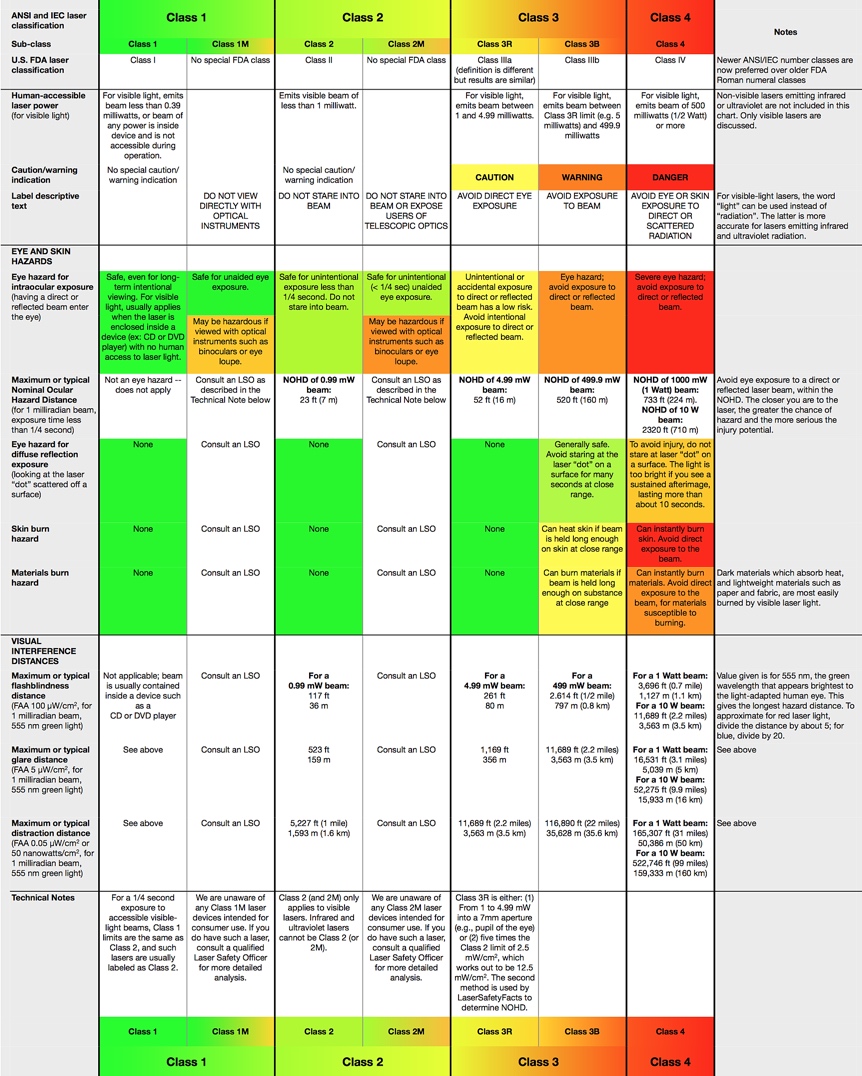Australian Laser Safety Standards
When it comes to using Laser Levels on a construction site Australian laser safety standards apply. There are certain rules, restrictions and things you should take into account.
Lasers have been classified by wavelength and power into four classes and a few subclasses since the early 1970s. The classifications categorize lasers according to their ability to produce damage in exposed people, from class 1 (no hazard during normal use) to class 4 (severe hazard for eyes and skin).
All Lasers in todays market are classified for safety purposes based on their potential for causing injury to humans’ eyes and skin.
Most laser products are required by law to have a label listing the Class. It will be listed either in Arabic numerals (1 2, 3R, 3B, 4) or in Roman numerals (I, II, IIIa, IIIb, IV).
For visible-beam consumer lasers, there are four main classes. Each is described in more detail here: Class 2, Class 3R, Class 3B and Class 4. The first two Classes are relatively safe for eye exposure; the last two are hazardous. The chart below shows how the eye injury hazard increases as the laser’s power increases.
Australian Laser Safety Standards – Laser Class Specifications
Nature of the Hazard
Lasers are capable of producing intense beams of coherent radiation at optical, UV and infra-red wavelengths. While lasers vary greatly in power output, wavelength and purpose, the hazard potential of the types used for research purposes can be significant. Because of the very high spectral brightness of most laser sources, such radiation can be extremely hazardous to the eyes and the skin and a number of cases of serious injury, including loss of sight, have been documented.
As a result, a number of international and Australian standards, which set out requirements for laser safety, have been published or revised in recent years. This guideline provides advice on the administrative measures needed to implement these standards in the university.
Options for Hazard Control
As with ionizing radiation, laser hazards may be controlled by the use of engineered controls, administrative controls and personal protective equipment, either singly or in combination. As a general principle engineered controls are preferred where appreciable hazards exist, although these may need, in some cases, to be supplemented by the use of appropriate eye protection.
Low powered lasers, such as those incorporated in consumer products, usually have a high degree of inherent safety and no additional safety measures are needed. The lasers used in research are often high power units and while engineered safety features are required, written safe working procedures are also important – particularly in research applications where equipment configurations may need to be altered frequently. This increases the importance of the safety awareness of users because more reliance must be placed on procedural safety measures and the use of protective equipment such as safety goggles.
Those responsible for laser use need to be aware that while laser controls are not addressed specifically in current legislation, injuries caused by a laser could fall within the domain of common law liability. In addition, failure to implement appropriate safety standards would constitute a breach of the employer’s obligations set out in the Workplace Health and Safety Act 1995. This reinforces the importance of compliance with well recognised Australian standards based on international recommendations.
Reference our Articles on Rotary Lasers “Laser Level Buying Guide” for more purchasing information.
Laser Classification
There are three important Australian standards applicable to lasers: AS/NZS 2211.1:1997 Laser Safety Part 1: Equipment classification, requirements and user’s guide. AS 2397: Safe use of lasers in the building and construction industry and AS/NZS 4173: Guide to the safe use of lasers in health care.
These divide lasers into six classes according to accessible emission limits. The classes are: 1, 2, 3A, 3B, 3B (restricted) and 4. The accessible emission limits for each class are given in tables for a range of laser wavelengths and exposure times.
The classification system can be broadly described in the following terms:
Class 1 lasers are those which are incapable of damaging the eyes or skin because of either engineered design or inherently low power output. The lasers used in CD players are the most common example of this category.
Class 2 lasers have sufficient power output to cause damage to the eyes if viewed continuously. However, their outputs are low enough to allow the natural aversion responses, such as blinking, to prevent damage. Additional hazard control measures take the form of cautionary signs or labels. The laser pointers often used by conference presenters are common examples.
Class 3A lasers have the potential to cause damage to the eyes from intra-beam viewing and precautions are required to prevent both direct viewing or viewing with optical instruments.
Class 3B (restricted) lasers operate at the same power levels as class 3A but have higher irradiance, i.e. higher power density, and consequently have some additional restrictions on use.
Class 3B lasers are more hazardous because of either higher output or operation outside visible wavelengths. In addition, specular reflections may also be hazardous. In general, more stringent controls are needed to prevent exposure.
Class 4 Lasers are high power devices capable of producing eye damage even from diffuse reflection. Skin damage is also possible from even brief exposures. Class 4 lasers may also constitute a fire hazard. Examples of class 4 lasers include entertainment lasers, surgical lasers and those used in the plastic, wood and metal fabrication industries.
Lasers for use in surveying, building or construction must be used in compliance with Australian Standard AS 2397-1993: Safe Use of lasers in the building and construction industry.
Laser manufacturers responsibilities summarised from the above listed Australian standard.
- It should be tested and correctly classified in accordance with the above listed laser classes.
- Scan failure should not cause radiation in excess of the classification limits.
The following information will be provided, in English, with every laser:
Adequate instructions for proper assembly, maintenance and safe use including clear instructions and precautions to be taken to avoid possible exposure to hazardous laser radiation.
- A statement in appropriate units of beam divergence for collimated beams, pulse duration and maximum output, with magnitudes of the cumulative measurement uncertainty and any expected increase in the measured quantities at any time after manufacture added to the values measured at the time of manufacture.
Legible reproductions (colour optional) of all required labels and hazard warnings to be affixed to the laser product or provided with the laser product. The corresponding position of each label affixed to the laser product shall be indicated or, if provided with the product, a statement of the form and manner in which they were supplied shall be provided.
- A clear indication of all locations of laser apertures.
- A listing of controls, adjustments and procedures for operation and maintenance, including the warning “Caution – use of controls or adjustments or performance of procedures other than those specified herein may result in hazardous radiation exposure”.
- In the case of laser products that do not incorporate the laser energy source necessary for laser emission, a statement of the compatibility requirements for a laser energy source to ensure safety.
- The manufacturer will also draw attention to the existence and the need to observe the relevant regulations and standard
- All employers of operators of class 2, class 3a and class 3b (restricted) lasers shall ensure they have appropriate training in the use of the laser and access to the relevant information necessary for safe operation of the laser.


